

Chip fab techniques help build living neural circuits. Researchers in Korea have taken a leaf out of the microengineer's book, and used lithographic techniques to build live neural circuits in a petri dish.
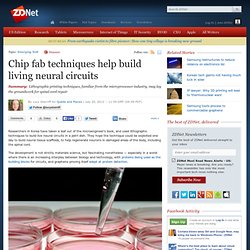
They hope the technique could be exploited one day to build neural tissue scaffolds, to help regenerate neurons in damaged areas of the body, including the spinal cord. The development is not strictly materials science, but fascinating nonetheless — especially in a world where there is an increasing interplay between biology and technology, with proteins being used as the building blocks for circuits, and graphene proving itself adept at protein detection. The researchers printed a variety of single-cell-sized shapes — including triangles, circles, hexagons, squares and stars — onto a culture substrate using microcontact printing, a form of soft lithography, with a mixture of poly-L-lysine and laminin A chain synthetic peptide.
Then they sprayed this surface with rat neurons that had been tagged with fluorescent dyes. Artificial Intelligence. And that's no dig at Google, according to artificial intelligence researchers Yann LeCun and Josh Tenenbaum.
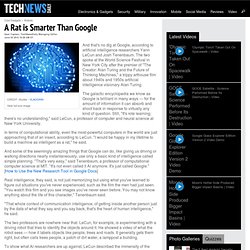
The two spoke at the World Science Festival in New York City after the premier of "The Creator: Alan Turing and the Future of Thinking Machines," a trippy arthouse film about 1940s and 1950s artificial intelligence visionary Alan Turing. The galactic encyclopedia we know as Google is brilliant in many ways — for the amount of information it can absorb and shoot back in response to virtually any kind of question. Still, "It's rote learning; there's no understanding," said LeCun, a professor of computer and neural science at New York University. In terms of computational ability, even the most-powerful computers in the world are just approaching that of an insect, according to LeCun.
"I would be happy in my lifetime to build a machine as intelligent as a rat," he said. The two professors are nowhere near that. Trivial Artificial Neural Network in Assembly Language. Source code for this article may be found here.

Note for nerds: The code shown in this article may be incomplete and may not contain all the security checks you would usually perform in your code as it is given here for demonstration purposes only. A Grand Unified Theory of Artificial Intelligence. In the 1950s and '60s, artificial-intelligence researchers saw themselves as trying to uncover the rules of thought.
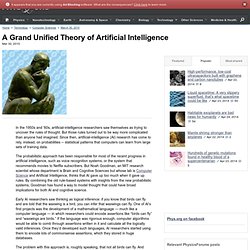
But those rules turned out to be way more complicated than anyone had imagined. Since then, artificial-intelligence (AI) research has come to rely, instead, on probabilities -- statistical patterns that computers can learn from large sets of training data. The probabilistic approach has been responsible for most of the recent progress in artificial intelligence, such as voice recognition systems, or the system that recommends movies to Netflix subscribers. But Noah Goodman, an MIT research scientist whose department is Brain and Cognitive Sciences but whose lab is Computer Science and Artificial Intelligence, thinks that AI gave up too much when it gave up rules. By combining the old rule-based systems with insights from the new probabilistic systems, Goodman has found a way to model thought that could have broad implications for both AI and cognitive science.
A Grand Unified Theory of Artificial Intelligence. Types of artificial neural networks. There are many types of artificial neural networks (ANN).
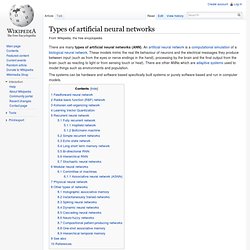
An artificial neural network is a computational simulation of a biological neural network. These models mimic the real life behaviour of neurons and the electrical messages they produce between input (such as from the eyes or nerve endings in the hand), processing by the brain and the final output from the brain (such as reacting to light or from sensing touch or heat). There are other ANNs which are adaptive systems used to model things such as environments and population. Biggest Scientific Breakthroughs of 2011.
Artificial Intelligence. Artificial intelligence. AI research is highly technical and specialized, and is deeply divided into subfields that often fail to communicate with each other.[5] Some of the division is due to social and cultural factors: subfields have grown up around particular institutions and the work of individual researchers.

AI research is also divided by several technical issues. Some subfields focus on the solution of specific problems. Others focus on one of several possible approaches or on the use of a particular tool or towards the accomplishment of particular applications. The central problems (or goals) of AI research include reasoning, knowledge, planning, learning, natural language processing (communication), perception and the ability to move and manipulate objects.[6] General intelligence is still among the field's long-term goals.[7] Currently popular approaches include statistical methods, computational intelligence and traditional symbolic AI.
History[edit] Research[edit] Goals[edit] Planning[edit] Logic-based. International Journal of Artificial Intelligence & Applications (IJAIA) « techcfp. ISSN : 0975-900X ( Online ); 0976-2191 (Print) Call for Paper.
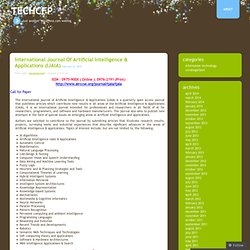
Artificial Intelligence: Predictive Modeling, Machine Learning, and Data Analytics. Machine Learning Algorithms: Predictive Modeling, Data Analytics, and Artificial Intelligence. Predictive Modeling Techniques: Machine Learning, Data Analytics, and Artificial Intelligence. Predictive Modeling Resources: Machine Learning, Artificial Intelligence, and Data Analytics. Machine Learning Techniques: Predictive Modeling, Data Analytics, and Artificial Intelligence.